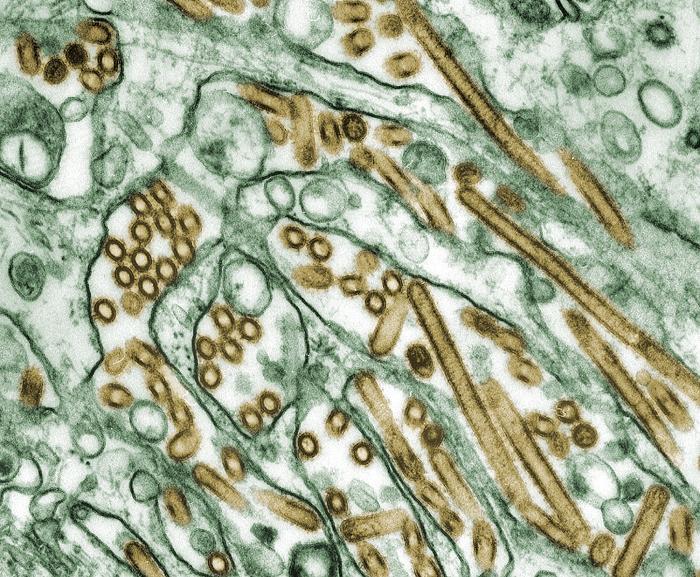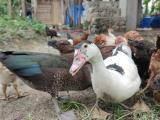A new strain of H5N1 avian influenza virus that has apparently gained predominance in Egypt in recent months may be associated with the sharp increase in human H5N1 cases there during that same time frame, an international team of scientists reported yesterday in Eurosurveillance.
The researchers said the new strain has spread widely in Egypt's poultry and that two recent H5N1 isolates from human patients fall into the same group. It's too early to tell if the strain has gained a greater ability to jump from birds to humans, they wrote, and further studies are needed to find out if that's the case.
At this point it can't be "excluded with certainty that the emerging phylotype of viruses may have increased zoonotic potential and may be transmitted more efficiently to humans, although this assumption cannot be drawn from the molecular evidence described here," the report states. The authors are from Egypt, Germany, and the United Nations Food and Agriculture Organization.
435 outbreaks in 5 months
The steep increase in human cases and poultry outbreaks in Egypt in the past several months has stirred speculation about whether mutations in the virus are better equipping it to spread in poultry and from poultry to humans. The report says 435 poultry outbreaks were reported by Egyptian veterinary authorities from October 2014 through February 2015.
Human H5N1 cases first occurred in Egypt in 2006, and a total of 204 confirmed cases were reported from 2006 through 2014, with a case-fatality rate of 35.8%, the researchers say. This year, the case total reached 116 as of Mar 21, with 36 deaths, or more than half the count for the preceding 9 years, they add.
For the study, the team selected a sample of 29 H5N1 isolates representing different poultry species, locations, and operations (commercial farms, backyard flocks, and live-bird markets). They generated sequence data for the hemagglutinin (HA) segments of all 29 viruses and for the neuraminidase (NA) genes of 15 isolates. In addition, they sequenced the entire genomes of four isolates.
Through a phylogenetic analysis to see where the viruses fit on the H5N1 family tree, the team concluded that they belong in a separate cluster within a previously defined clade, 2.2.1.2. They further found that none of the older viruses from that clade have been detected in Egypt since last October, indicating that the new strain has become predominant.
The sequence data for the internal genes of the viruses agree with the findings for the HA and NA sequences, "indicating that the new viruses represent a distinct cluster that originated from previously circulating viruses of clade 2.2.1.2," the report says.
In addition, the team found that two H5N1 viruses collected from infected humans last November "are part of the same expanding cluster," with similar mutation patterns. The two are the only publicly available sequences of viruses from recent human cases in Egypt.
HA mutations
An analysis of the HA sequence revealed one amino-acid change, K373R, that appeared to be characteristic of the emerging strain, in that it had been seen only rarely in the past. Three other mutations in the strain are associated with increased binding to human-type flu virus receptors, but these mutations had been seen in earlier clade 2.2.1 viruses in Egypt, the article says.
"Since no substituting mutations were found in HA epitopes, we do not expect marked differences in the antigenic properties of the emerging phylotype compared with the previously circulating clade," the report says. It adds that this was partly confirmed by testing how viruses of the new strain and other H5 viruses reacted with antibodies from birds that had been exposed to various H5 strains.
The team also found four amino-acid changes in the new strain's NA gene. Three of these were at sites on the protein that induce B- or T-cell responses by the immune system.
The authors comment that a new H5N1 cluster emerged in Egypt once before but did not become predominant. A strain that was designated as clade 2.2.1.1 emerged in late 2007 and expanded in poultry, but then disappeared until the end of 2010. It did not replace 2.2.1 viruses, and it apparently caused only one human case.
The team writes that it's hard to assess whether or not the recent increase in poultry H5N1 outbreaks in Egypt is attributable to the biological properties of the new strain in poultry or not.
"In any case, the observed recent rise in outbreaks in poultry probably resulted in increased exposure risks for humans in contact with poultry, which may have caused an increased incidence in human cases," they write. Their findings don't prove that the new strain jumps to humans more easily, they add, but the possibility can't be ruled out.
Ferret studies needed
The authors call for further studies of the pathogenicity and transmissibility of the viruses, possibly using ferrets. In addition, they cite an urgent need for veterinary and public health authorities in Egypt to collaborate to stop circulation of the virus in Egypt's poultry.
A moderator with ProMED, the reporting service of the International Society of Infectious Diseases, agreed about the need for more research on the new cluster. Laura D. Kramer, PhD, director of the arbovirus laboratories of the New York State Department of Health's Wadsworth Center in Albany, said the findings raise questions about the molecular determinants that increased the "fitness" of the strain and the selective pressures acting on it.
"Studies of the pathogenicity and transmissibility of these viruses, most likely using the ferret model, need to be conducted to answer the question of whether the genetic changes are affecting the current outbreak," she wrote.
Arafa AS, Naguib MM, Luttermann TT, et al. Emergence of a novel cluster of influenza A(H5N1) virus clade 2.2.1.2 with putative human health impact in Egypt, 2014/15. Euro Surveill 2015 Apr 2;20:13 [Full text]
See also:
Apr 2 ProMED-mail post
Related Jan 7 CIDRAP News story
Related Jan 13 CIDRAP News story





















